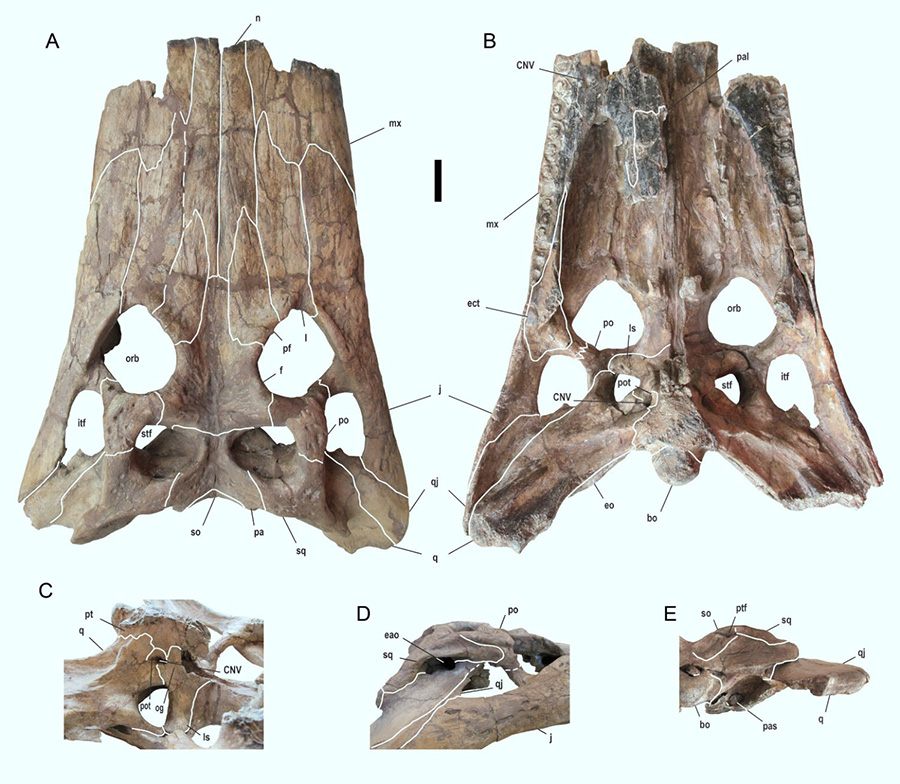Deinosuchus schwimmeri: New Species of Ancient Giant Alligator Identified

A new species of crocodilian related to modern alligators has been identified from fossils found in Mississippi and Alabama, the United States. Named Deinosuchus schwimmeri, it lived between 75 and 82 million years ago (Cretaceous period) and had teeth the ‘size of bananas,’ capable to take down even the very largest of dinosaurs.
Deinosuchus is a genus of giant (over 10 m, or 33 feet, in length) crocodylians from the Late Cretaceous of North America.
These creatures were the largest semiaquatic predators in their environments, longer and heavier than their predatory competitors, and are known to have fed on large vertebrates, including contemporaneous dinosaurs.
Two Deinosuchus species, Deinosuchus hatcheri and Deinosuchus riograndensis, lived in the west of America, ranging from Montana to northern Mexico.
The newly-described species, Deinosuchus schwimmeri, lived along the Atlantic coastal plain from New Jersey to Mississippi.
“Deinosuchus was a giant that must have terrorized dinosaurs that came to the water’s edge to drink,” said Dr. Adam Cossette, a researcher in the Department of Basic Sciences at the New York Institute of Technology College of Osteopathic Medicine at Arkansas State University and the Department of Earth and Environmental Sciences at the University of Iowa.

Dr. Cossette and his colleague, University of Iowa’s Professor Christopher Brochu, studied new and previously found material to review species-level systematics of Deinosuchus and help refine its phylogenetic placement among crocodilians.
“Until now, the complete animal was unknown. The new specimens we’ve examined reveal a bizarre, monstrous predator with teeth the size of bananas,” Dr. Cossette said.
Based on its enormous skull, Deinosuchus looked like neither an alligator nor a crocodile.
Its snout was long and broad, but inflated at the front around the nose in a way not seen in any other crocodylian, living or extinct. The reason for such enlarged nose is unknown.
“It was a strange animal,” Professor Brochu said.
“It shows that crocodylians are not ‘living fossils’ that haven’t changed since the age of dinosaurs. They’ve evolved just as dynamically as any other group.”
“It had two large holes are present at the tip of the snout in front of the nose,” Dr. Cossette added.
“These holes are unique to Deinosuchus and we do not know what they were for, further research down the line will hopefully help us unpick this mystery and we can learn further about this incredible creature.”
“Deinosuchus seems to have been an opportunistic predator, and given that it was so enormous, almost everything in its habitat was on the menu,” said Dr. Stephanie Drumheller-Horto, a paleontologist at the University of Tennessee who was not involved in the current study.
“We actually have multiple examples of bite marks made by Deinosuchus riograndensis and a species described in this study, Deinosuchus schwimmeri, on turtle shells and dinosaur bones.”
The study was published in the Journal of Vertebrate Paleontology.
_____
Adam P. Cossette & Christopher A. Brochu. A systematic review of the giant alligatoroid Deinosuchus from the Campanian of North America and its implications for the relationships at the root of Crocodylia. Journal of Vertebrate Paleontology, published online July 29, 2020; doi: 10.1080/02724634.2020.1767638
Source: www.sci-news.com/








